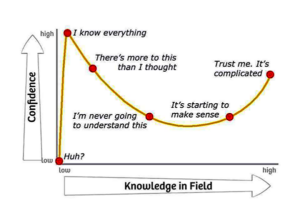
Lately, I’ve been completely rethinking my views on eschatology, that branch of theological study dealing with the “last days” aka the “end times.” For the first 50 years of my walk with God, I was aligned to one degree or another with the prevailing dispensationalist school of theology which has championed the ideas of the Rapture of the Church followed by the appearance of the Antichrist followed by a 7-year Great Tribulation followed by the Battle of Armageddon followed by the 1,000-year earthly reign of Christ followed by the Final Judgment and the descent to earth of the New Jerusalem.
Whew! What a mouthful! I just caught myself competing with the Apostle Paul for the title of “King of Run-on Sentences!”
All seriousness aside, that prayerful reevaluation has resulted in my abandoning the whole modern end-times paradigm. As a result, I’ve already taken down my only 2 prior articles on the topic, both of which had that viewpoint as their conceptual foundation.
This series is their replacement. Be forewarned this my 10,000-foot view on the topic; for me to truly do it justice would require writing an entire book.
Why the Drastic Shift?
My journey on this particular topic this far into my walk with God has been what you could call “Holy-Spirit-accidental.” It started with my stumbling across some YouTube videos on the subject. These, in turn, caused me to reexamine my 50 years of end-times assumptions. My curiosity being further aroused, I felt led to conduct my own research and, finally, am writing my current findings in this article.
That being said, my odyssey continues…
During that journey, I’ve come to the reluctant conclusion that most, if not all, the prevailing theological teachings concerning the end times are — at least in my own mind — completely bogus. Modern eschatology is shot through with more terrible hermeneutics, false assumptions, and even occasional outright falsehoods than I had thought possible for a theological viewpoint so widely accepted throughout evangelical Christendom.
The prevailing view, dispensationalism, valiantly tries hard just to “make it all work.” In other words, a tremendous amount of effort has been expended to make perfect sense of some very lofty, intense, and hard-to-grasp Bible passages, most of which strain the understanding and credulity of our modern Western mindset. We Greco-Roman-Western-Civilization types tend to arrogantly demand the things of God fall neatly into clearly defined categories with scientific precision and zero anomalies, exceptions, or vagaries. Our Lord, on the other hand, seems to get an immense kick out of evading all our attempts to accomplish this.
Until now, I’ve been a bit reluctant to come out publicly on this because so many ministers — literally all of whom are far more renowned and highly regarded than yours truly — have espoused the dispensationalist viewpoint on the end-times for the last 170 years or so and counting. That list is composed of a veritable who’s-who of theologians, pastors, teachers, and televangelists, many of whose names you would quickly recognize if I listed them here.
But this article isn’t about famous personalities and what they think, but what the Bible says. Or at the very least, what I think it says for the time being.
The Dunning-Kruger Effect
 Tragically, as with all topics theological nowadays, there are innumerable self-proclaimed social media “experts” on the end times. Just mention eschatology in passing on FaceBook or X (formerly Twitter) and you will instantly have them swarming around you like a bunch of angry bees whose hive has just been raided by Winnie the Pooh.
Tragically, as with all topics theological nowadays, there are innumerable self-proclaimed social media “experts” on the end times. Just mention eschatology in passing on FaceBook or X (formerly Twitter) and you will instantly have them swarming around you like a bunch of angry bees whose hive has just been raided by Winnie the Pooh.
I’m not one of them.
I have, however, developed sufficient knowledge to be somewhere between the “it’s starting to make sense” and the “trust me, it’s complicated” point on the Dunning-Kruger Effect curve shown at right.
The Problem
The theological trap both they — and formerly I — fell into is two-fold:

- The Bible contains passages which are clear and others which are figurative or symbolic. This is especially true when addressing the topic at hand. Proper hermeneutics requires us to not only clearly distinguish between the two, but also interpret the figurative portions in light of the clear ones, not the other way around. Much of dispensationalist eschatology violates that by reversing the two.
- We, as members of Western Civilization living in the scientific era along with our attendant modernist cultural biases, have a huge tendency to take figurative portions of the Bible and interpret them literally, whereas the original hearers back in the day would have had a far better grasp of the prophetic language used in the Scriptures, thus leading to a proper interpretation. The writers of both testaments were Jewish in their worldview (hereafter Hebraic); our trying to interpret their writings using our modern-day Greco-Roman thought processes (hereafter Hellenistic) causes us to miss quite a lot of nuance when trying to properly construe the prophetic language occurring in either one.
Case-in-point: Jesus said during His Olivet Discourse:
Immediately after the tribulation of those days the sun will be darkened, and the moon will not give its light; the stars will fall from heaven, and the powers of the heavens will be shaken…
Matthew 24:29When we Westerners read this verse, our tendency is to interpret that sentence literally in light of modern scientific discoveries: there is going to be a solar eclipse and other observable astronomical events. Actually, such prophetic phraseology has been used multiple times throughout the Old Testament to indicate God’s judgment upon a variety of other nations, including Egypt, Idumea, Babylon, Samaria, and others. All those judgments have already occurred in the ancient past, yet here we are thousands of years later with a perfectly functional sun, moon, stars, and skies.
Divine Mysteries
In my humble opinion, there is no human being — least of all me — qualified to speak in absolutes on this topic.
Why?
Because the majority of eschatology is shrouded in divine mystery.
Such mysteries defy our puny human abilities to intellectually fathom them. We Christ-followers are required to accept them by simple faith apart from our flesh-driven-knowledge-is-power cravings for exhaustive understanding. We can look into such mysteries to our hearts’ content, examine them from every angle, explore all the Scripture references, read all the commentaries, and listen to our theological betters until we are blue in the face, but the bottom line is such matters are — and will always remain this side of eternity — just that: mysteries.
The ability to tolerate and accept divine mystery is a direct barometer of our child-likeness before our Heavenly Father. And, as I’ve said elsewhere here on Miscellaneous Ramblings, every heresy which has ever been invented throughout church history was instigated by one or more bozos who pressed on regardless, desperately trying to pound the square peg of a divine mystery into the round hole of their intrinsically flawed human intellect.
So I will not be offering any new insights, opinions, and/or scientific wild guesses as replacements for dispensationalist eschatology here because I have no answers, only more questions than when I first started. The only thing I do know is this: we evangelicals have been collectively sold a bill of goods when it comes to end times theology.
If you’ll permit me a reference to one of my all-time favorite sci-fi movies, The Matrix, I now offer you a choice between the blue pill and the red pill. The blue pill is you dismissively blowing off the rest of this article without reading further, secure in your preexisting theological assumptions on this topic. If you choose the red pill, we’ll reexamine those preconceptions and find out just how deep this rabbit-hole goes. Then you can decide for yourself where to stand on these issues.
You game? Here we go!
The Challenges of Interpreting Biblical Prophesy
I believe the two of the most significant challenges when dealing with biblical prophesy are these:
- Bible prophesies were written within the cultural milieu and frame-of-reference (lifestyle, worldview, symbology, and social norms) of a specific audience living within a given geographic region during a unique era in history. In each case, God was speaking through a prophet to that target audience, all of whom shared those cultural reference points, so the Almighty could be clearly understood by His listeners.
That being said, we are now beneficiaries of all that, privileged to learn from both the audience’s good and bad choices as well as the attendant revelation of God’s character, will, and ability.
Years, centuries, even millennia later, subsequent Bible scholars of every stripe have brought their own cultural assumptions and mental filters to the table, all of which are significantly different from the original prophet and his audience. These combine to hinder both their and our perceptions of what was said and how to interpret its meaning. The rule of thumb is this: the further away in time and/or the greater the cultural differences, the more pronounced that obstacle tends to be. We today are farther away than anyone else in the history of mankind.
The Old Testament was written in Hebrew and Aramaic (both Semitic languages) using Hebraic concepts and terminology to a Hebraic audience having a Hebraic frame-of-reference. Even though the New Testament was written in Koine Greek, its authors all wrote from that same Hebraic mindset and its shared cultural assumptions.
Also, the Bible was written across a timespan measured in thousands of years. Each of the authors wrote in the vernacular of their time, so even interpreters from only a hundred years or so after something was written shared the same challenges as we do, only somewhat less so.
Accordingly, when exegeting prophesy, we with a Hellenistic heritage must work diligently to bypass our own cultural mindsets, biases, and narratives to decipher the true meaning(s) of what was originally spoken and why. Therein lies a seemingly insurmountable challenge. That being said, the Holy Spirit is both ready and willing to help us overcome that obstacle if we but have ears willing to listen and the humility to recognize and allow Him to work in us to overcome our cultural limitations.
- Prophesies in Scripture are rarely understood in advance, almost always fully grasped only in retrospect after they have been fulfilled. We then do a face-palm and exclaim, “Oh, cool! That’s what God meant by that!”
Jesus Himself is a significant case-in-point. We can find literally hundreds of Old Testament prophesies concerning His incarnation. They all can be binned into 2 seemingly contradictory portraits of Him superimposed over one another:
- Suffering Servant
- Reigning King
When He appeared the first time around, it was as the former; when He comes back, it will be the latter.
What the Jewish scholars prior to His first advent could not see was the immense gulf of time between the two views. Today, when we look at Isaiah 53, Psalm 22, and similar prophesies, we can easily, immediately, and clearly perceive how those passages described the Suffering Servant view and marvel at how specifically they were fulfilled in the birth, life, ministry, death, and resurrection of Messiah.
However, when we examine prophesies concerning His return as King, we are oftentimes left scratching our heads, going “Huh!? What’s that about?”
In our next installment, we’ll explore some end-times terminology: what those terms are, what they have meant historically, and whether those historical interpretations hold any water. We’ll also explore how some of all that may have already been fulfilled back in the 1st century.
Thanks for reading!

